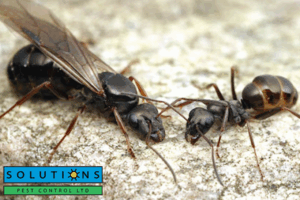Carpenter ants are often mistaken for termites, especially when they take flight or tunnel into wood. But while these ants may not consume wood like termites, they can still cause serious structural damage over time. What makes carpenter ants especially troublesome is their silent, gradual destruction often going unnoticed until visible signs like sawdust piles or winged intruders emerge.
In this article, we’ll help you understand the early signs of carpenter ants in house, what makes your property attractive to them, and how to take proactive steps before they turn your home into a colony site.
What Are Carpenter Ants?
Carpenter ants are large, black or dark reddish insects that can grow up to 13 mm in length. Unlike termites, they don’t eat wood but excavate it to build nests. This excavation weakens wood structures, particularly in moisture-damaged areas. Winged carpenter ants also called swarmers are often the first visible warning of a larger infestation.
If you’ve recently noticed do carpenter ants bite inquiries popping into your mind after spotting one, the answer is yes they can. Though bites are rare and not venomous, their strong mandibles can break skin if provoked.
Early Signs of a Carpenter Ant Infestation
1. Sawdust Piles (Frass)
One of the earliest signs of carpenter ants is the presence of frass fine, sawdust-like material pushed out of galleries as they tunnel through wood. These piles usually accumulate beneath baseboards, window sills, and door frames.
2. Faint Rustling Noises
You might hear faint rustling or tapping inside walls, especially at night when carpenter ants are most active. This sound comes from their movement and excavation efforts inside wooden structures.
3. Winged Ants Indoors
Finding winged ants indoors, especially near windows or light fixtures, is a strong indicator that a mature colony is nesting nearby. Swarmers typically appear in spring or early summer when carpenter ants are reproducing. If you’re dealing with this, it’s time to search for ant control near me before the infestation spreads.
4. Hollow-Sounding Wood
Tap on suspect wooden beams or walls. If the wood sounds hollow or feels soft and crumbles under pressure, there’s a chance carpenter ants have been tunneling inside it.
5. Live Ant Trails
Carpenter ants forage for food and water, typically at night. You may spot them traveling in trails along walls, plumbing lines, or trees leading into your home.
What Attracts Carpenter Ants to Homes?
Understanding the conditions that attract these wood-damaging pests is crucial to prevention. Here are a few common culprits:
Moisture
Carpenter ants prefer damp, decaying wood. Leaky pipes, poorly ventilated crawl spaces, and water-damaged roofing can all create ideal nesting environments.
Unsealed Openings
Gaps in siding, window frames, or utility lines give ants easy access into your home. Once inside, they locate hidden cavities within the walls or flooring.
Outdoor Nesting Sites
Trees with rotting trunks, old stumps, or stacked firewood near your home can serve as launching points for carpenter ants to move indoors.
How Carpenter Ant Infestations Spread Indoors
Once inside, carpenter ants often build satellite nests away from the main colony. These nests can exist in wall voids, insulation, hollow doors, or attics. The spread is facilitated by the availability of moisture and undisturbed wood. They prefer not to be seen, which is why infestations can continue unchecked for months or even years.
Their silent expansion makes it imperative to act fast upon detecting any signs of carpenter ants in the house.
Carpenter Ants vs. Termites: Know the Difference
Many homeowners confuse carpenter ants with termites, especially during the swarming season. Here’s a quick comparison:
- Waist: Carpenter ants have a narrow, pinched waist, while termites have a straight body.
- Antennae: Antennae on carpenter ants are elbowed, while termite antennae are straight.
- Wings: Ants’ front wings are longer than the back pair; termites have equal-length wings.
- Behavior: Termites eat wood; carpenter ants excavate it.
This distinction matters because the treatment methods vary significantly. Whether you’re inquiring about pest control Vancouver or termite treatments, the correct identification is key to effective removal.
Why Early Detection Is Critical
Delaying action can lead to escalating damage and higher repair costs. Structural beams, joists, and wooden floors can be compromised over time. Even worse, once satellite nests develop, DIY solutions are often ineffective. Professional inspections help locate all active nesting zones and assess the severity of the damage.
Prevention Tips for Homeowners
To prevent carpenter ant infestations:
- Repair water leaks and ensure proper ventilation
- Seal gaps around windows, doors, and pipes
- Remove dead trees, stumps, or wood piles from your yard
- Trim branches that touch your roof or siding
- Store food securely and keep counters clean
Consistent vigilance paired with expert guidance is your best line of defense. If you’ve been looking into ant control near me or wondering about early detection services, don’t wait until the damage is visible.

When to Call a Pest Professional
Carpenter ants are notoriously resilient. Over-the-counter products may only kill surface foragers but fail to reach the nest. If you see swarmers or find ongoing signs of wood damage, it’s time to consult a professional pest control provider.
A trained technician will inspect, identify the infestation type, and apply treatment using green and safe pesticides to target the colony at its source. Their expertise ensures long-term protection and peace of mind.
If you’re dealing with carpenter ants and need Vancouver pest control that’s fast, effective, and eco-conscious, help is just a click away.
About Solutions Pest Control
Solutions Pest Control is your trusted partner for residential and commercial pest management in Vancouver, BC, and surrounding areas. Our expert team offers a wide range of services including general pest removal, rodent control, and targeted solutions for ant infestations using safe, environmentally responsible methods.
We understand the stress and disruption pests cause, which is why we tailor our services to your home’s unique needs. From early identification of black ants in house to customized plans for carpenter ants, we deliver lasting results without compromising your health or the environment.


